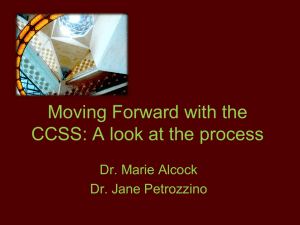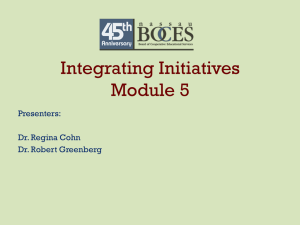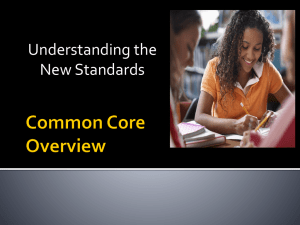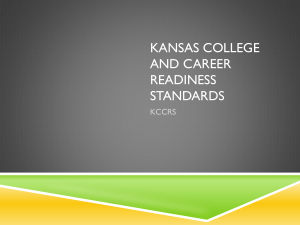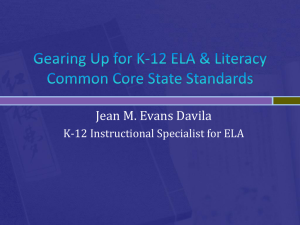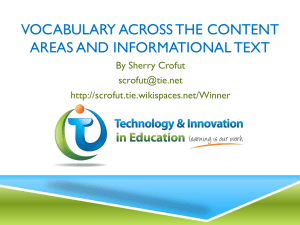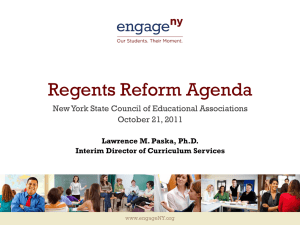Common Core Standards - Orange Public Schools
advertisement
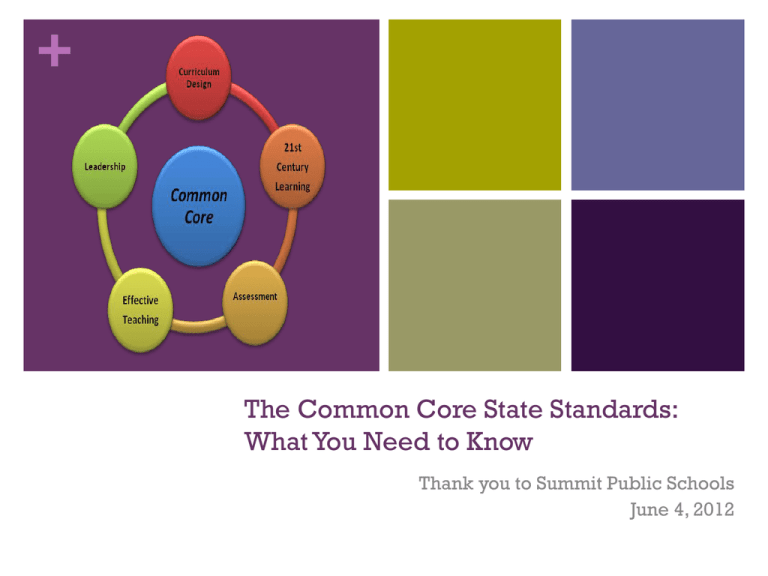
+ The Common Core State Standards: What You Need to Know Thank you to Summit Public Schools June 4, 2012 + Do ever feel like you’re on fast forward? + The Common Core State Standards: Background State led effort by the National Governors Association Center for Best Practices and the Council of Chief State School Officers Provide clear and consistent frameworks to prepare children for college and the workforce Informed by highest most effective models from states across the country and countries around the world Define the knowledge and skills students should have within their K-12 education Focus on WHAT not HOW + NJCCCS and the Common Core: What’s the Difference? Common Core State Standards for English Language Arts and Math CCSS for English Language Arts and Literacy in History/Social Studies, Science, and Technical Subject NJCCCS still exist for: Science Visual & Performing Arts Health and PE (Model Curriculum now available on NJDOE website) Technology 21st Century Life & Career World Languages Social Studies + English Language Arts Common Core State Standard Information + Balancing Informational & Literary Texts – Increase in teaching and learning with non-fiction text Range of Text Types Literature = Stories, Dramas, Poetry Informational = Literary Nonfiction, Historical, Scientific, & Technical Texts 12th gradeGrade 12 Grade 8 th 8 grade 20% Grade 4 fiction 4th grade 40% 80% fiction nonfiction 50% 60% fiction nonfiction 50% nonfiction + ELA/Literacy Shift 1: Balancing Informational and Literary Text What the Student Does… What the Teacher Does… What the Principal Does… •Build background knowledge to increase reading skill •Exposure to the world through reading •Apply strategies to reading informational text •Provide students equal #s of informational and literary texts •Ensure coherent instruction about content •Teach strategies for informational texts •Teach “through” and “with” informational texts •Scaffold for the difficulties that informational text present to students •Ask students, “What is connected here? How does this fit together? What details tell you that? “ •Provide equal amounts of informational and literacy text to students •Hold teachers accountable for building student content knowledge through text •Provide PD and co-planning opportunities for teachers to become more intimate with non fiction texts and the way they spiral together 7 + ELA/Literacy Shift 2: Grades 6-12 Knowledge in the Disciplines What the Student Does… What the Teacher Does… What the Principal Does… •Become better readers by building background knowledge •Handle primary source documents with confidence •Infer, like a detective, where the evidence is in a text to support an argument or opinion •See the text itself as a source of evidence (what did it say vs. what did it not say?) •Shift identity: “I teach reading.” •Stop referring and summarizing and start reading •Slow down the history and science classroom •Teach different approaches for different types of texts •Treat the text itself as a source of evidence •Teach students to write about evidence from the text •Teach students to support their opinion with evidence •Ask : “How do you know? Why do you think that? Show me in the text where you see evidence for your opinion. “ •Support the role of all teachers in advancing students’ literacy •Provide guidance and support to ensure the shift to informational texts for 6-12 •Give teachers permission to slow down and deeply study texts with students 8 + ELA/Literacy Shift 3: Staircase of Complexity What the Student Does… What the Teacher Does… What the Principal Does… •Read to see what more they can find and learn as they reread texts again and again •Read material at own level to build joy of reading and pleasure in the world •Be persistent despite challenges when reading; good readers tolerate frustration •Ensure students are engaged in more complex texts at every grade level •Engage students in rigorous conversation •Provide experience with complex texts •Give students less to read, let them re-read •Use leveled texts carefully to build independence in struggling readers •More time on more complex texts •Provide scaffolding • Engage with texts w/ other adults •Get kids inspired and excited about the beauty of language •Ensure that complexity of text builds from grade to grade. •Look at current scope and sequence to determine where/how to incorporate greater text complexity •Allow and encourage teachers to build a unit in a way that has students scaffold to more complex texts over time •Allow and encourage teachers the opportunity to share texts with students that may be at frustration level 9 + ELA/Literacy Shift 4: Text Based Answers What the Student Does… What the Teacher Does… What the Principal Does… •Go back to text to find evidence to support their argument in a thoughtful, careful, precise way. •Develop a fascination with reading •Create own judgments and become scholars, rather than witnesses of the text. •Conducting reading as a close reading of the text and engaging with the author and what the author is trying to say. •Facilitate evidence based conversations with students, dependent on the text. •Have discipline about asking students where in the text to find evidence, where they saw certain details, where the author communicated something, why the author may believe something; show all this in the words from the text. •Plan and conduct rich conversations about what the writer is writing about. •Keep students in the text •Identify questions that are textdependent, worth asking/exploring, deliver richly. •Provide students the opportunity to read the text, encounter references to another text, another event and to dig in more deeply into the text to try and figure out what is going on. •Spend much more time preparing for instruction by reading deeply. •Allow teachers the time to spend more time with students writing about the texts they read- and to revisit the texts to find more evidence to write stronger arguments. •Provide planning time for teachers to engage with the text to prepare and identify appropriate text-dependent questions. •Create working groups to establish common understanding for what to expect from student writing at different grade levels for text based answers. •Structure student work protocols for teachers to compare student work products; particularly in the area of providing evidence to support arguments/conclusions. + ELA/Literacy Shift 5: Writing from Sources What the Student Does… What the Teacher Does… What the Principal Does… •Begin to generate own informational texts. •Expect that students will generate their own informational texts (spending much less time on personal narratives). •Present opportunities to write from multiple sources about a single topic. •Give opportunities to analyze, synthesize ideas across many texts to draw an opinion or conclusion. •Find ways to push towards a style of writing where the voice comes from drawing on powerful, meaningful evidence. •Give permission to students to start to have their own reaction and draw their own connections. •Build teacher capacity and hold teachers accountable to move students towards informational writing. + ELA/Literacy Shift 6: Academic What the Student Does… What the Teacher Does… What the Principal Does… Vocabulary •Spend more time learning words across “webs” and associating words with others instead of learning individual, isolated vocabulary words. •Develop students’ ability to use and access words that show up in everyday text and that may be slightly out of reach. •Be strategic about the kind of vocabulary you’re developing and figure out which words fall into which categories- tier 2 vs. tier 3. •Determine the words that students are going to read most frequently and spend time mostly on those words. •Teach fewer words but teach the webs of words around it. •Shift attention on how to plan vocabulary meaningfully using tiers and transferability strategies. •Provide training to teachers on the shift for teaching vocabulary in a more meaningful, effective manner. 12 + Math Common Core State Standard Information Mathematical Standards for Practice AND Content Describe ways students should engage with math as they grow: •Making sense of problems •Using varied approaches •Connecting prior learning •Modeling •Using tools strategically •Use of vocabulary & symbols to be precise •Look for & make sense of structure Focus on the domains of math: •Counting and cardinality •Operations and algebraic thinking •Number and operations & Base-10 •Measurement and Data •Geometry + Priorities in Math Grade P–2 3–5 6 7 8 Priorities in Support of Rich Instruction and Expectations of Fluency and Conceptual Understanding Addition and subtraction, measurement using whole number quantities Multiplication and division of whole numbers and fractions Ratios and proportional reasoning; early expressions and equations Ratios and proportional reasoning; arithmetic of rational numbers Linear algebra + Key Fluencies Grade Required Fluency P-K Add/subtract within 5 1 Add/subtract within 10 Add/subtract within 20 2 3 Add/subtract within 100 (pencil and paper) Multiply/divide within 100 Add/subtract within 1000 4 Add/subtract within 1,000,000 5 Multi-digit multiplication 6 Multi-digit division Multi-digit decimal operations 7 Solve px + q = r, p(x + q) = r 8 Solve simple 22 systems by inspection + Mathematics Shift 1: Focus What the Student Does… What the Teacher Does… What the Principal Does… •Spend more time thinking and working on fewer concepts. •Being able to understand concepts as well as processes (algorithms). •Make conscious decisions about what to excise from the curriculum and what to focus. •Pay more attention to high leverage content and invest the appropriate time for all students to learn before moving onto the next topic. •Think about how the concepts connects to one another •Build knowledge, fluency and understanding of why and how we do certain math concepts. •Work with groups of math teachers to determine what content to prioritize most deeply and what content can be removed (or decrease attention). •Determine the areas of intensive focus (fluency), determine where to re-think and link (apply to core understandings), sampling (expose students, but not at the same depth). •Determine not only the what, but at what intensity. •Give teachers enough time, with a focused body of material, to build their own depth of knowledge. 17 + Mathematics Shift 2: Coherence What the Student Does… What the Teacher Does… What the Principal Does… •Build on knowledge from year to year, in a coherent learning progression. •Connect the threads of math focus areas across grade levels. •Think deeply about what you’re focusing on and the ways in which those focus areas connect to the way it was taught the year before and the years after. •Ensure that teachers of the same content across grade levels allow for discussion and planning to ensure for coherence/threads of main ideas. 18 + Mathematics Shift 3: Fluency What the Student Does… What the Teacher Does… •Spend time practicing, •Push students to know with intensity, skills (in high basic skills at a greater volume). level of fluency. •Focus on the listed fluencies by grade level. •Create high quality worksheets, problem sets, in high volume. What the Principal Does… •Take on fluencies as a stand alone CC aligned activity and build school culture around them. 19 + Mathematics Shift 4: Deep Understanding What the Student Does… What the Teacher Does… What the Principal Does… •Show, through numerous ways, mastery of material at a deep level •Use mathematical practices to demonstrate understanding of different material and concepts •Ask yourself what mastery/proficiency really looks like and means •Plan for progressions of levels of understanding •Spend the time to gain the depth of the understanding •Become flexible and comfortable in own depth of content knowledge •Allow teachers to spend time developing their own content knowledge •Provide meaningful professional development on what student mastery and proficiency really should look like at every grade level by analyzing exemplar student work 20 + Mathematics Shift 5: Application What the Student Does… What the Teacher Does… What the Principal Does… •Apply math in other content areas and situations, as relevant •Choose the right math concept to solve a problem when not necessarily prompted to do so •Apply math including areas where its not directly required (i.e. in science) •Provide students with real world experiences and opportunities to apply what they have learned •Support science teachers about their role of math and literacy in the science classroom •Create a culture of math application across the school 21 + Mathematics Shift 6: Dual Intensity What the Student Does… What the Teacher Does… What the Principal Does… •Practice math skills with an intensity that results in fluency •Practice math concepts with an intensity that forces application in novel situations •Find the dual intensity between understanding and practice within different periods or different units •Be ambitious in demands for fluency and practice, as well as the range of application •Provide enough math class time for teachers to focus and spend time on both fluency and application of concepts/ideas 22 + Timeline Core Curriculum Content Standards (K-12) Implementation of Curricula Common Core ELA September 2012 Common Core Math K-2- September 2011 3-5 & High School September 2012 6-8 September 2012 Science September 2011 Visual & Performing Arts Health and PE Technology 21st Century Life & Career World Languages September 2012 Social Studies September 2012 + PARCC’s focus Building a comprehensive assessment system for the purpose of measuring student progress against the CCSS Defining consistent and clear expectations of the skills students need in order to compete in college and the workplace. Starting in 2012-13: > test formats will remain similar to 2011-12 > but content will begin to align to Common Core > ELA/Literacy - assessments will include more informational text > Math - assessments will focus on prioritized standards + ELA/LITERACY SHIFTS IN ASSESSMENT Balancing Informational & Literary Texts - Passages will be authentic and balanced across informational and literary. Knowledge in the Content Areas - Assessment will contain knowledge-based questions about the informational text; students will not need outside knowledge to respond. Grade-level Text Complexity - Passage selection will be based on text complexity that is appropriate to grade level per Common Core. Text-based Answers & Writing from Sources - Questions will require students to marshal evidence from the text, including from paired passages. Academic Vocabulary - Students will be tested directly on the meaning of pivotal, common terms from which the definition can be discerned from the text. Academic vocabulary will also be tested indirectly through general comprehension of the text. + MATH SHIFTS IN ASSESSMENT Focus - Priority standards will be the focus of the assessments. Other standards will be deemphasized. Coherence - Assessments will reflect the progression of content and concepts as depicted in the standards across grade levels. Fluency - It will be assumed that students possess the required fluencies as articulated through grade 8; as such, there will be no calculators in early grades. Deep understanding - Each standard will be assessed from multiple perspectives while not veering from the primary target of measurement for the standard. Application and Dual Intensity - Students will be expected to know grade-level math content with fluency and to know which math concepts to employ to solve real-world math problems. + Student Growth Percentiles and Methodologies Go to NJDOE website. Select the DATA tab Select the NJSMART link Select Student Performance on the left hand side There you will see a whole page with information on the Student Growth Percentiles including a video that goes through the whole methodology. + Parking Lot



